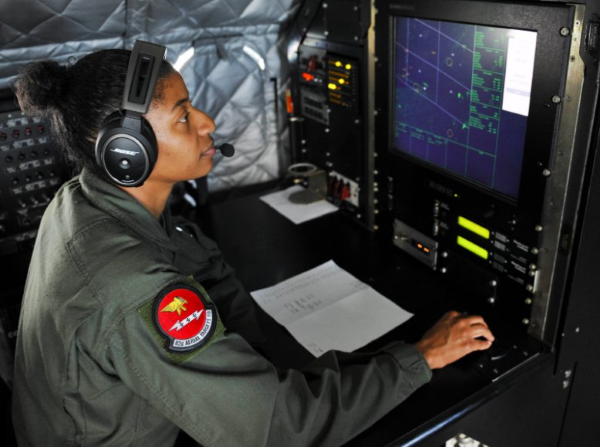If having an Air Force career that’s demanding and has lots of flying hours greatly appeals to you, then being an Air Force Airborne Mission Systems Operator may be a perfect fit for you.
Airmen who act in this capacity in the Air Force play a major role in managing the battlespace during tactical and strategic missions.
- Be able to perform aircrew duties on a wide variety of airborne platforms
- Operate, maintain, repair, and test airborne communications equipment such as electro-optical sensors, radars, electronic protection (EP) systems, and electronic warfare (EW) systems
- Supervise the maintenance of airborne equipment systems and also be prepared to train aircrews on their use
- Inspect and operate airborne communications in coordination with ground, air and sea surface units
- Determine optimum airborne equipment settings
- Gather, record and distribute information between several different command units
- Operate and respond to aircraft emergency systems and equipment
The effective command and control services that an Air Force Airborne Mission Systems Operator provides are critical to pilots, sailors and ground units to ensure the success of their missions.
Those who enter into this career field will become key contributors in ‘Managing the Chaos of War’.
Jump To A Section
Air Force Airborne Mission Systems Operator Requirements and Qualifications
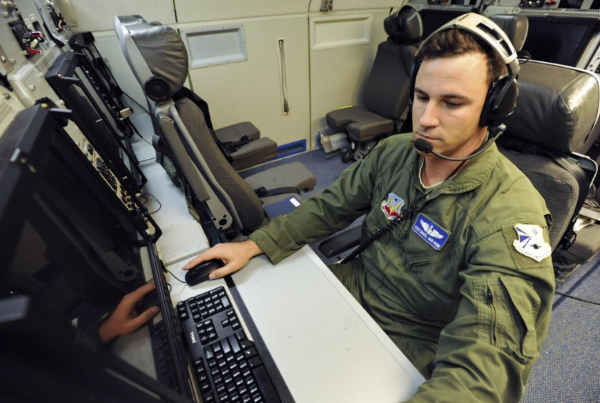
An enlisted person who aspires to be an Air Force Airborne Mission Systems Operator must first meet all of these prerequisite requirements in order to be eligible to pursue entry into this demanding Air force career field.
Educational Requirements
- High School Diploma
- GED
- GED with 15 college credits
ASVAB Requirements
- Minimum ASVAB Score of 70 in the electrical category
Additional Qualifications
- Be between the ages of 17 and 39
- Height must be between 64 inches and 77 inches – no exceptions
- Have normal color vision and depth perception
- Be able to lift 70 lbs.
- Meet all other physical qualifications for aviation service
- Having background knowledge of electronics is much desired but not required
- Successful completion of 8.5 weeks of Air Force Basic Military Training held at Joint Base Lackland in San Antonio, TX (Not required of those with prior military experience or training)
- Must take the steps necessary to maintain eligibility to deploy and mobilize worldwide on a moment’s notice.
- Completion of a current Single Scope Background Investigation (SSBI) in order to obtain a Secret level or higher security clearance.
Once all of these conditions have been met an Airman will then proceed to their next duty assignment to commence technical training.
Training and Career Path to Become an Air Force Airborne Mission Systems Operator
There are three critical phases of training that are required in order for an airman to be able to fulfill the duties of an Air Force Airborne Mission Systems Operator on their own.
They are as follows:
Air Force Technical Training Information
Despite the steep learning curve in this career field, the technical training course for it is not that long.
An airman that has just completed Air Force basic training does not have to go far to get to their technical training school either.
That’s because it too is located right on Joint Base Lackland in San Antonio, TX.
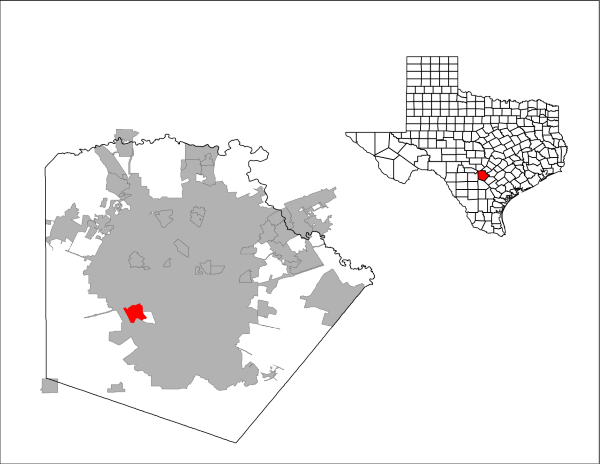
Most candidates to become Air Force Airborne Mission Systems Operator’s will be finished with their technical training in as little as 6 weeks.
By the halfway point of technical training school, an Airman should have been made aware of the place of their next duty assignment.
Once an Airman completes technical training for this Air Force career field, they will receive college credits toward a Community College of the Air Force degree in Information Systems Technology.
Aircrew Training
All enlisted Air Force personnel that work in positions that require flying must participate in several aircrew training courses before being allowed to fly.
These courses consist of:
- Enlisted Aircrew Undergraduate Course
This course is undertaken at Lackland AFB in San Antonio, TX and lasts just over 2 weeks.
- Combat Survival Training Course
This is a 17-day course held at Fairchild AFB near Spokane, Washington.
- Water Survival-Parachuting Course
Conducted at Pensacola NAS in Pensacola, FL. The course is approximately 4 days long.
There may be other short courses required too for any airman who wants to be part of a flight crew.
Your recruiter should be privy to the latest information on the aircrew requirements that are applicable to this Air Force specialty.
On the Job Training
The technical training is short for this Air Force specialty because it’s best learned by doing.
That means an airman who wants to be an Air Force Airborne Mission Systems Operator can expect several months of intense hands-on training.
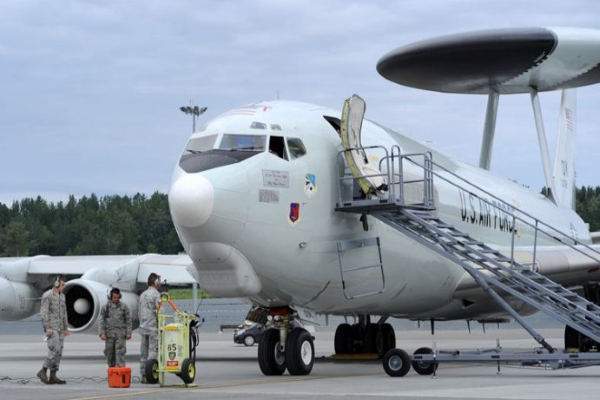
This training will be closely supervised by senior enlisted personnel that has worked in this career field for many years.
Once an airman becomes proficient at their assigned duties, they will then be integrated into their squadron’s normal work routine as a qualified Air Force Airborne Mission Systems Operator.
How Much Are Air Force Airborne Mission Systems Operators Paid?
As with all Air force enlisted positions, there is a set pay scale for every enlisted rank.
This pay scale considers two factors when determining an Air Force enlisted members pay.
Those factors are the person’s current rank and the amount of time that person has spent in the service.
Without prior military experience, it’s very hard for anyone to enter into the Air Force at a higher rank than Airman First Class (E-3).
Most likely a recruit with no experience in their career field will start out as an Airman Basic (E-1).
Those with some relevant work experience, background or college courses relating to their career field may be able to start out with a rank of Airman (E-2) or Airman First Class (E-3).
A person’s Air Force recruiter will discuss the starting pay grade with each individual recruit.
Related Article: 41 Questions To Ask A Military Recruiter;
The 2019 pay scale for enlisted Airmen with less than two years of prior military experience is as follows:
Airman Basic (E-1): $1,680.83/Month
Airman (E-2): $1,884.09/Month
Airman First Class (E-3): $1,982.27/Month
This is what’s considered to be take-home pay.
Miscellaneous Pay and Incentives
There are other factors that contribute to an Airman’s pay also.
This takes into consideration such things as an individual airman’s duty assignment and living situations.
These include such miscellaneous and other incentive pay as:
- Housing allowance for those that live off base (BAH)
- Subsistence allowance (Food – BAS)
- Temporary duty pay
- Hazardous duty pay
- Flight pay
Health care is always 100% covered for Air Force enlisted personnel.
Related Article – 10 Benefits Of Being A Military Wife (and 5 not-so good things)
What’s Life Like as an Air Force Airborne Mission Systems Operator?
When one becomes an Air Force Airborne Mission Systems Operator they will certainly not have the typical 9 to 5 lifestyle that some Air Force specialties enjoy.
There will be numerous hours spent getting ready to fly and up in the air doing their jobs.
Last-minute flight changes, temporary duty assignments, and fast response to developing security situations around the world become routine for an Air Force Airborne Mission Systems Operator.
This makes this job extremely tough to manage for those with dependents.
So if a more routine lifestyle is important to you, then it’s best to choose another Air Force specialty.
When stationed at larger bases there are, however, numerous opportunities that an airman can take advantage of.
These include:
- The opportunity to participate in based sponsored sports and recreation
- The ability to take advantage of reduced price on base shopping facilities
- Use of the gyms, sports courts, bowling, swimming and golf facilities that exist on many large Air Force Installations
- Weekly days off and 30-days leave with pay each year
Airborne Operations Job Reviews
Those who work in this Air Force career field and can handle the pressures that comes with the job and the constant moving around tend to enjoy it.
Here is what some former Air Force and Air Force Reserve Airborne Mission Systems Operators had to say about their experiences on Indeed.com:
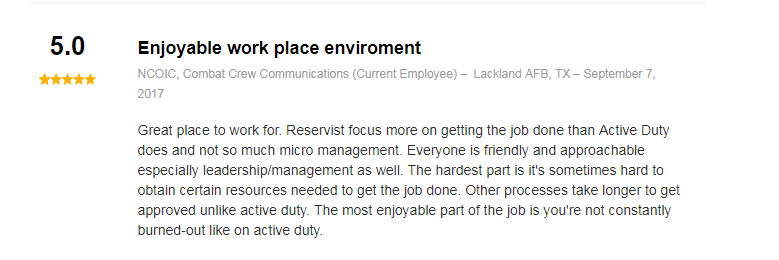

Air Force Airborne Mission Systems Operator Civilian Career Opportunities
There are not an abundance of civilian jobs that directly correlate with being an Airborne Mission Systems Operator but there are some.
They are also many civilian jobs that can use people that have experience working with such things as radar and advanced communication devices.
Some civilian companies also value having an employee that already possesses a valid secret level or above security clearance.
Here are some examples of some companies that may be able to use the services of a skilled former Air Force Airborne Mission Systems Operator include:
- MAG Aerospace – Oklahoma City, OK
- Adams Communication & Engineering Technology – Reston, VA
- Sierra Nevada Corporation – Mary Esther, FL
- Boeing Aerospace Company – Chicago, IL
- General Dynamics Corporation – Falls Church, VA
- Raytheon Company – Waltham, MA
These jobs feature a wide variety of salaries but one can expect to start at $45,000 a year or better in most cases with their Air Force Airborne Mission Systems Operator background.
Government Civilian Employment Opportunities
Certain branches of the government can use the skills that one attains from doing the job of an Air Force Airborne Mission Systems Operator.
They include:
- Air Force/Air Force Reserve (for training purposes in most cases) – Various Locations
- Defense Intelligence Agency – Washington, D.C.
- National Imagery and Mapping Agency (NIMA) – Springfield, Virginia
- Department of Homeland Security – Washington, DC
One must keep in mind that ex-Air Force personnel that work for the government will have their Air Force time count towards pay, retirement and the number of paid vacation days they are allowed each year.
Ex-Air Force Airborne Mission Systems Operators can expect a starting GS pay level that will compensate them somewhere between $40,000 – $70,000 a year and comes with full benefits too.
Related Article: 9 Common Private Military Contractor Jobs (and 3 uncommon ones)
References:
Official Air Force Recruiting Page
Air Force Reserve Official Page
- 5 Worst Jobs in the Air Force - June 20, 2024
- 4 Steps For Visiting An Air Force Recruiter Near You - June 19, 2024
- Air Force Safety Specialist (1S0X1) - June 19, 2024
Originally posted on July 17, 2019 @ 4:29 pm
Affiliate Disclosure: This post may contain affiliate links. If you click and purchase, I may receive a small commission at no extra cost to you. I only recommend products I have personally vetted. Learn more.
